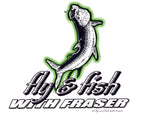The silhouette of a fly is crucial when targeting tarpon. Often fished in clear, shallow waters, tarpon rely heavily on visual cues. A well-defined silhouette, even without intricate details, allows them to easily identify the offering as potential prey. Darker silhouettes against a bright sky or lighter water are particularly effective in creating contrast and drawing their attention. The size and shape of the silhouette should generally mimic the local baitfish or shrimp. A natural, enticing profile is key to triggering a strike from these discerning predators.
Expanding on the importance of a fly's silhouette for tarpon, consider the angle of presentation. Tarpon often look up towards the surface, so the fly's profile from below is paramount. A bulky or unnatural silhouette can immediately deter a wary fish. Fly tyers meticulously craft patterns to achieve the desired shape and size when wet, understanding that materials behave differently in the water.
Think about the speed and movement of the fly in relation to its silhouette. A jerky, erratic retrieve combined with a slender profile might imitate a fleeing baitfish, while a slower, more deliberate movement with a wider silhouette could suggest a shrimp or crab. The contrast between the fly's silhouette and the ambient light also plays a significant role. On bright days, a darker silhouette stands out, whereas on overcast days, a lighter or more translucent profile might be more effective. Ultimately, the goal is to present a silhouette that appears natural and appealing to the tarpon in the specific conditions.




